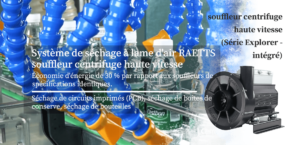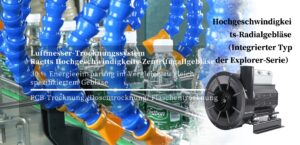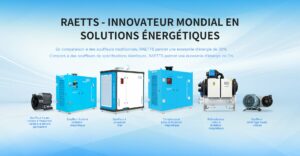RAETTS is located in Dongguan, Guangdong Province, the world’s leading manufacturing city and the hinterland of Guangdong-Hong Kong-Macao Greater Bay Area. The existing R&D and production base area of more than 30,000㎡, Central China factory is located in Ganzhou, Jiangxi Province. RAETTS have realized the R&D and intellectual manufacturing of the whole industrial chain of blowers and compressors. RAETTS has set up a number of subsidiaries in Beijing, Tianjin, Jiangsu, Sichuan, Guangxi and other provinces and cities to provide high-quality and convenient services to customers nationwide; in addition, RAETTS customers have spread to Thailand, Malaysia and many other countries.
Innovation has never stopped, technology is the king. After more than ten years of innovation and development, RAETTS has broken through the international technology monopoly and created a mature air bearing blower and maglev turbo blower dual production lines firstly in the industry, pioneered the portable and the miniature type air bearing blower. In recent years, RAETTS has innovated and developed technical equipment such as maglev centrifugal refrigeration compressors and heat pump units, maglev centrifugal turbo compressors, maglev centrifugal chillers and permanent magnet high-efficiency motors, which have been highly recognized by the market and become star products in the field of energy supply and energy saving.
RAETTS suspension blower has been recognized by the Ministry of Industry and Information Technology as an “Energy Efficiency Star” equipment product, and has been selected for the national energy-saving technology and equipment recommendation catalog. Global customer feedback shows that the energy saving rate of RAETTS blower and compressor is more than 30% compared to traditional blower and compressor and more than 5% compared to the same type of blower and compressor.
An Ultimate FAQ Guide:
2.What Are the Benefits of Maglev Turbo Air Compressor?
3.How Long Does a Maglev Turbo Air Compressor Last?
4.How Does Maglev Technology Work in a Compressor?
5.What Are the Advantages of Using a Maglev Turbo Air Compressor?
6.How Reliable Is a Maglev Turbo Air Compressor?
7.What Are the Different Types of Maglev Turbo Air Compressor?
8.How Are Maglev Turbo Air Compressors Installed?
9.What Are the Key Performance Parameters of a Maglev Turbo Air Compressor?
10.How Does a Maglev Turbo Air Compressor Operate?
11.How Much Does a Maglev Turbo Air Compressor Cost?
12.What Maintenance Is Required for a Maglev Turbo Air Compressor?
13.What Are the Safety Precautions for a Maglev Turbo Air Compressor?
14.How Do You Troubleshoot a Maglev Turbo Air Compressor?
15.What Features Make Maglev Turbo Air Compressors More Efficient?
16.What Are the Different Sizes and Capacities of Maglev Turbo Air Compressors?
17.What Types of Applications Require Maglev Turbo Air Compressors?
18.How Can I Get the Best Performance Out of My Maglev Turbo Air Compressor?
19.How Is the Noise Level of a Maglev Turbo Air Compressor?
1.What Is the Maglev Turbo Air Compressor?
The Maglev Turbo Air Compressor is a type of air compressor that uses magnetic levitation technology to reduce friction and increase efficiency. This type of air compressor is designed to be more efficient than traditional air compressors, as it uses magnets to reduce the amount of energy needed to compress air. The Maglev Turbo Air Compressor is also quieter than traditional air compressors, making it ideal for use in residential and commercial settings.
2.What Are the Benefits of Maglev Turbo Air Compressor?
1. Increased Efficiency: Maglev turbo air compressors are more efficient than traditional air compressors, as they use magnetic levitation technology to reduce friction and increase efficiency. This means that they require less energy to operate, resulting in lower energy costs.
2. Quiet Operation: Maglev turbo air compressors are much quieter than traditional air compressors, as the magnetic levitation technology reduces the noise generated by the compressor. This makes them ideal for use in residential and commercial settings.
3. Longer Lifespan: Maglev turbo air compressors have a longer lifespan than traditional air compressors, as the magnetic levitation technology reduces wear and tear on the compressor. This means that they require less maintenance and can last for many years.
4. Compact Design: Maglev turbo air compressors are much smaller than traditional air compressors, making them ideal for use in tight spaces. This makes them perfect for use in workshops, garages, and other areas where space is limited.
3.How Long Does a Maglev Turbo Air Compressor Last?
The life expectancy of a maglev turbo air compressor depends on the quality of the compressor and how it is maintained. Generally, a maglev turbo air compressor should last between 10 and 15 years with proper maintenance.
4.How Does Maglev Technology Work in a Compressor?
Maglev technology is a type of magnetic levitation technology that uses magnets to suspend an object in the air. In a compressor, maglev technology is used to reduce friction and vibration, allowing the compressor to run more efficiently and quietly. The compressor has a series of magnets that are arranged in a specific pattern. When the compressor is running, the magnets create a magnetic field that lifts the compressor off the ground, reducing friction and vibration. This allows the compressor to run more efficiently and quietly.
5.What Are the Advantages of Using a Maglev Turbo Air Compressor?
1. Increased Efficiency: Maglev turbo air compressors are designed to be more efficient than traditional air compressors. This means that they require less energy to operate, resulting in lower energy costs.
2. Quieter Operation: Maglev turbo air compressors are designed to be quieter than traditional air compressors. This makes them ideal for use in areas where noise levels need to be kept to a minimum.
3. Longer Lifespan: Maglev turbo air compressors are designed to last longer than traditional air compressors. This means that you can expect to get more years of use out of your compressor.
4. Compact Design: Maglev turbo air compressors are designed to be more compact than traditional air compressors. This makes them ideal for use in areas where space is limited.
5. Improved Performance: Maglev turbo air compressors are designed to provide improved performance over traditional air compressors. This means that you can expect to get more power and better performance from your compressor.

6.How Reliable Is a Maglev Turbo Air Compressor?
Maglev turbo air compressors are generally considered to be very reliable. They are designed to be efficient and durable, and they are built with high-quality components. They are also designed to be easy to maintain and repair, which helps to ensure that they remain reliable over time.
7.What Are the Different Types of Maglev Turbo Air Compressor?
1. Permanent Magnet Synchronous Motor (PMSM) Maglev Turbo Air Compressor: This type of maglev turbo air compressor uses a permanent magnet synchronous motor to drive the compressor. It is a highly efficient and reliable type of compressor, and is often used in industrial applications.
2. Electromagnetic Suspension (EMS) Maglev Turbo Air Compressor: This type of maglev turbo air compressor uses an electromagnetic suspension system to suspend the compressor in the air. This type of compressor is more efficient than the PMSM type, and is often used in medical and laboratory applications.
3. Hybrid Maglev Turbo Air Compressor: This type of maglev turbo air compressor combines the features of both the PMSM and EMS types. It is a highly efficient and reliable type of compressor, and is often used in industrial applications.
8.How Are Maglev Turbo Air Compressors Installed?
Maglev turbo air compressors are typically installed in a dedicated room or area that is well-ventilated and free from dust and other debris. The compressor should be placed on a level surface and secured to the floor or wall. The air intake and exhaust should be connected to the compressor and the power supply should be connected to the compressor. The compressor should be connected to the air lines and the pressure regulator should be adjusted to the desired pressure. Finally, the compressor should be tested to ensure it is working properly.
9.What Are the Key Performance Parameters of a Maglev Turbo Air Compressor?
1. Airflow: The amount of air that the compressor can move in a given period of time.
2. Pressure: The amount of pressure the compressor can generate.
3. Efficiency: The amount of energy used to generate the desired pressure.
4. Noise: The amount of noise generated by the compressor.
5. Reliability: The ability of the compressor to operate without failure.
6. Maintenance: The amount of maintenance required to keep the compressor running.
7. Cost: The cost of the compressor and associated components.
10.How Does a Maglev Turbo Air Compressor Operate?
A maglev turbo air compressor operates by using a combination of magnetic levitation and turbocharging. The compressor uses a magnetic field to levitate the compressor’s rotor, which is then spun by an electric motor. This spinning rotor creates a vacuum, which draws in air from the atmosphere. The air is then compressed by the turbocharger, which is powered by the electric motor. The compressed air is then released into the system, providing a boost of power.

11.How Much Does a Maglev Turbo Air Compressor Cost?
The cost of a maglev turbo air compressor can vary greatly depending on the size and type of compressor you are looking for. Generally, a maglev turbo air compressor can cost anywhere from $500 to $5,000 or more.
12.What Maintenance Is Required for a Maglev Turbo Air Compressor?
The maintenance requirements for a maglev turbo air compressor are similar to those of any other air compressor. Regularly check the oil level and change the oil as recommended by the manufacturer. Check the air filter and replace it if necessary. Inspect the air intake and exhaust for any blockages or debris. Check the belts and pulleys for wear and tear and replace them if necessary. Finally, inspect the motor and electrical components for any signs of damage or wear and replace them if necessary.
13.What Are the Safety Precautions for a Maglev Turbo Air Compressor?
1. Always wear safety glasses and hearing protection when operating the compressor.
2. Make sure the compressor is properly grounded and connected to a GFCI outlet.
3. Keep the compressor away from combustible materials and flammable liquids.
4. Make sure the compressor is properly vented to prevent the build-up of combustible gases.
5. Inspect the compressor regularly for signs of wear and tear.
6. Make sure the compressor is properly lubricated and all moving parts are in good condition.
7. Make sure the compressor is not overloaded and that the pressure switch is set correctly.
8. Make sure the compressor is not operated in an area with high humidity or extreme temperatures.
9. Make sure the compressor is not operated near open flames or sparks.
10. Make sure the compressor is not operated near any combustible materials or flammable liquids.
14.How Do You Troubleshoot a Maglev Turbo Air Compressor?
1. Check the power supply: Make sure the power supply is connected and that the power switch is in the “on” position.
2. Check the air filter: Make sure the air filter is clean and free of debris.
3. Check the air pressure: Make sure the air pressure is set to the correct level.
4. Check the air intake: Make sure the air intake is not blocked or restricted.
5. Check the air outlet: Make sure the air outlet is not blocked or restricted.
6. Check the motor: Make sure the motor is running properly and that the blower is spinning.
7. Check the compressor: Make sure the compressor is not leaking oil or other fluids.
8. Check the oil level: Make sure the oil level is at the correct level.
9. Check the hoses: Make sure the hoses are not cracked or leaking.
10. Check the valves: Make sure the valves are not stuck or leaking.
15.What Features Make Maglev Turbo Air Compressors More Efficient?
1. Magnetic Levitation Technology: Maglev turbo air compressors use magnetic levitation technology to reduce friction and increase efficiency. This technology uses magnets to suspend the compressor’s rotor in mid-air, eliminating contact between the rotor and the compressor housing. This reduces friction and increases efficiency.
2. High-Speed Rotor: Maglev turbo air compressors use a high-speed rotor to increase air pressure and flow. This rotor is designed to spin at a higher speed than traditional compressors, allowing it to generate more air pressure and flow.
3. Variable Speed Control: Maglev turbo air compressors feature variable speed control, allowing users to adjust the speed of the compressor to match their needs. This allows users to optimize the compressor’s performance for specific applications.
4. Low Noise Levels: Maglev turbo air compressors are designed to operate at low noise levels, making them ideal for use in noise-sensitive environments.

16.What Are the Different Sizes and Capacities of Maglev Turbo Air Compressors?
Maglev Turbo Air Compressors come in a variety of sizes and capacities. The smallest size is a 1/4 HP model, which is capable of producing up to 1.5 CFM of air flow. The largest size is a 5 HP model, which is capable of producing up to 25 CFM of air flow. The most common sizes are 1/2 HP, 1 HP, 2 HP, 3 HP, and 5 HP.
17.What Types of Applications Require Maglev Turbo Air Compressors?
Maglev Turbo Air Compressors are ideal for applications that require high-pressure air, such as pneumatic tools, paint spraying, and air-powered machinery. They are also used in industrial processes such as vacuum forming, blow molding, and air-powered cutting tools. Additionally, they are used in medical and laboratory applications, such as powering medical equipment and laboratory instruments.
18.How Can I Get the Best Performance Out of My Maglev Turbo Air Compressor?
1. Make sure your Maglev Turbo Air Compressor is properly maintained. Regularly check the oil level, air filter, and other components to ensure they are in good working order.
2. Ensure that the compressor is properly sized for the job. If the compressor is too small, it will not be able to provide the necessary air pressure and volume.
3. Make sure the compressor is installed in a well-ventilated area. This will help to keep the compressor cool and reduce the risk of overheating.
4. Use the correct air pressure and volume for the job. Too much air pressure or volume can cause the compressor to overwork and reduce its efficiency.
5. Make sure the compressor is not running for extended periods of time. This can cause the compressor to overheat and reduce its efficiency.
6. Make sure the compressor is not running in an environment with high humidity. This can cause the compressor to overheat and reduce its efficiency.
19.How Is the Noise Level of a Maglev Turbo Air Compressor?
The noise level of a maglev turbo air compressor is typically quite low. Most models are designed to operate at a noise level of around 60 decibels, which is comparable to the sound of a normal conversation.



